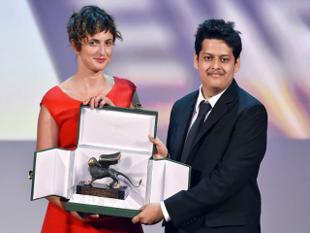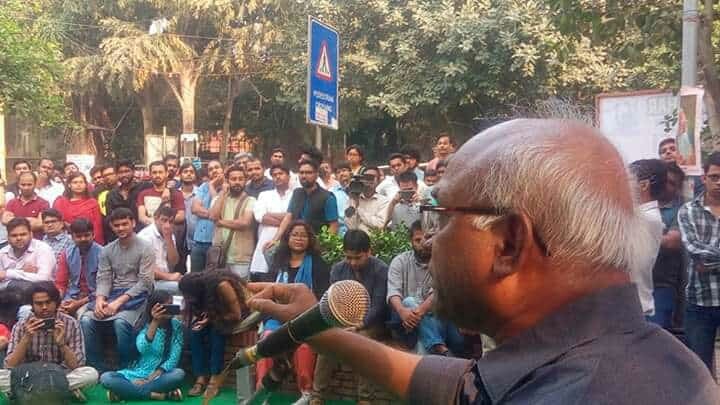Dhruwa R
The Marathi movie, Court, has been making news for some time now, being seen as a ‘radical’ movie even before its release in theaters in India – because it has won many awards nationally and globally. The movie is touted as a ‘never-before’ kind of attempt which apparently exposes the rampant injustice in the judicial processes in India. But is this a valid claim?

Chaitanya Tamhane receives award at the Venice International Film Festival
Has the movie done justice while handling sensitive issues concerning marginal people like Dalits and how they are treated by the brahminical judiciary? Is it worth being named as the movie which shall shake our very foundational beliefs? Does it indeed show the reality or does it only mask it and present it otherwise? And can it be seen in isolation from existing political realities, namely the fact that we have a so-called right wing regime when the movie gets a ‘national’ award? Is this just incidental or based on pure ‘merit’? These are important questions not only because the movie has won several awards and accolades (which have to be seen within the reality of the caste structure too) but also for the extremely sensitive subject that it has chosen to handle and the team that is behind the making of this movie.
The opinion, even if one doesn’t go by the brahminical media reports alone, is unanimously positive. Some people claim that the movie depicts the realities of the labouring class working in dire conditions in Mumbai and elsewhere, without any safety gear while cleaning gutters, while some others are express patronizing sympathy for the false implication of the vidrohi Dalit balladeer in the movie and seem aghast at the judiciary/bureaucracy for its lethargy and associated corruption. Even some Dalit friends have liked the movie for showing the balladeer’s fight and for how the movie has made a few brahmins feel uncomfortable by referring to a few brahmins in the higher echelons of power in the judiciary. These were portrayed as being superstitious, corrupt, manipulative and hinduised.This limited portrayal, which is in fact just a formal aspect and convenient to depict, is something we are supposed to thank the savarna director Mr. Tamhane for. That brahminism is the essential problem has conveniently been left aside and this is exactly how the brahminical powerplay continues its stronghold even through this movie.
One doesn’t really have to dig deep to find out how this brahmin machinery functions. In India, the brahmins continue to hegemonise the discourse whether it is in academia, judiciary, bureaucracy or media, and hence movie making is no exception. The brahmins never leave any opportunity to occupy all political positions, from conservative to progressive to radical, and ensure their class continues to be the ruling one. Maintaining the status quo is their ultimate aim.
So in the list of the so-called ‘liberal’, ‘meritorious’ and ‘progressive’ directors, one finds two strands of brahmins. One strand is clearly led by people like Satyajit Ray who made movies which showed either brahmin victimhood or brahmin glory or both. Many of the “critically acclaimed” Ray movies revolve around brahmins: a brahmin couple, the husband being a temple priest, a poor fellow; or a brahmin widow whose prodigal son is caught in a quandary whether to study or earn money by becoming a priest just like his deceased father; or a poor bright brahmin boy stuck somewhere in a communist regime, again led by brahmins.
The second strand is that of people like Chaitanya Tamhane or Anand Patwardhan who will selectively show a corrupt or a ‘hinduised’ system, and will focus all their blame on the ‘right wing’ but will never ever show the bond of fraternity that runs through these brahmins’ janeus which keeps them in solidarity with each other (even when superficially in opposition) and tacitly complicit in not allowing the real root cause, namely brahminism, to be attacked ever. They continue to earn awards, trot around the globe and exploit and appropriate the hard and brave fight put up by Dalits.
This movie, Court, then is no different. It shows the impatience of two people from a certain backward community who when criticized by a savarna lawyer for regressive community practices go on to blacken his face. This is the in-your-face blatant stereotyping of these ‘categories’ of people as regressive and illiterate since they can’t understand ‘civil’ way of protesting and are somehow against the freedom of speech. At the same time, a brahmin judge is shown to be merely superstitious, greedy and insensitive, yet, he is only part of the larger system which is corrupt and individual follies of his character remain only individual and don’t necessarily represent the entire brahmin community in a similar fashion. This is very sophisticated and dangerous brahminism, which despite its arrogant casteism, deceives everyone into believing that the brahmins are the torchbearers for change.

‘They continue to earn awards, trot around the globe and exploit and appropriate the hard and brave fight put up by Dalits’. Picture courtesy: Glamsham.com
Even Babasaheb was clear that it is impossible to believe that a brahmin in power, whichever field it may be, can ever be honest or revolutionary, and this has been proven throughout our history. Anand Patwardhan presents the Dalits as an incapable lot in Jai Bhim Comrade although it was the same Dalits who tamed Bal Thackeray on the Riddles issue and have kept Babasaheb’s legacy alive all these years. Patwardhan even went on to express surprise and incomprehension in The Hindu, a newspaper run by his fellow brahmins, in 2013, when Villas Ghogre – a Dalit and the main protagonist in Jai Bhim Comrade – asserted his Ambedkarite identity, despite his political affiliation to the communists, as he gave up his life for the cause. Patwardhan’s need to ‘understand’ this is typical brahminical patronization and leads to false and problematic depiction of Dalits in his hands. Further, the brahmins have their own ‘comrades’ like Anupama Rao who mark such a project like Patwardhan’s as a ‘take on Dalit Marxism’. Those who died, and the protagonist who gave up his life denouncing the Brahmin Marxists also are then seen to be comrades following this brand of Marxism. The next level would be that of saying perhaps that caste issues raised by Ambedkar could be located in some eastern Marxism as that of Lenin’s. So Ambedkar virtually doesn’t exist and the solution is to be found in some or the other form of Marxism.
Similarly, in ‘Court’, the savarna director ensures that the Dalit balladeer Narayan Kamble is shown as a sorry figure, not worthy of being listened to. Thus, the film does not allow the balladeer to assert his Ambedkarism beyond a few photos and statues in Dalit ghettos. Tamhane, the ‘progressive’ savarna director shows the hypocrisy of the brahmin lawyer and the judges but is cunning enough to portray their behaviour essentially as a failure of the system and not as brahminical hegemony which has ruined the lives of the masses for years and still continues to do so. These are actually facets of Brahminism – the real time and reel time, working in tandem. So when ‘real’ time judiciary actually incentivizes Ghar Wapsi and furthers Brahminism, ‘reel’ time doesn’t lag behind by blaming it on the corrupt system and thus exonerating the brahmins delivering justice.
This movie is a continuation of that hegemony and status quo, while disguised as an attempt to take on the system, it furthers the same injustice that it claims to expose. It is not anywhere close to being anti-caste.
~~~
Dhruwa R., is an entrepreneur based in Mumbai.
Pictures courtesy: the net









